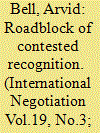| Srl | Item |
| 1 |
ID:
135248


|
|
|
|
|
| Summary/Abstract |
Resistance to negotiation and the continuation of violence dictate the course of events in the Afghanistan conflict. However, several studies have thoroughly explored the interests of the main parties to the conflict and a settlement that respects their key demands is possible. The current military situation resembles a “hurting stalemate,” which according to rationalist assumptions should compel the parties to move toward negotiations. This article argues that the main obstacle to negotiation is an underlying and unaddressed conflict of recognition between the United States, the Afghan government, and the Taliban. While each party believes it is driven by justice claims, they perceive their opponents to be driven by a hostile strategy informed by incompatible interests. Relying on the Cultural Theory of International Relations, this article explores the parties’ motives in the conflict, focusing on the need to strive for esteem and honor. It suggests that the reciprocal acknowledgement of legitimate identity-related justice claims could remove a key obstacle to formal negotiation.
|
|
|
|
|
|
|
|
|
|
|
|
|
|
|
|
| 2 |
ID:
088203


|
|
|
|
|
| Publication |
2009.
|
| Summary/Abstract |
According to the "Comprehensive Work Program of Energy Efficiency and Emission Reduction" of the Chinese government, during the period of the "11th Five-Year Plan", 1.5×108 m2 of existing residential buildings in China's northern heating region are to be retrofitted for energy efficiency. However, at present, this "Energy Efficiency Retrofit for Existing Residential Buildings" (EERFERB) faces many obstacles. Under the current working and market system, both the central and local governments and the energy supply companies can not push on this work smoothly. Using both the results of the annual national special inspection of building energy efficiency and some case analyses, this paper examines the necessity for energy efficiency retrofit, along with the relationships among the various Political, Economic, Social, Technological, Environmental and Legal (PESTEL) factors affecting it. Furthermore, organizational, financial and technical support systems are explored to promote the development of retrofit. Finally, some primary principles to be followed toward the implementation of EERFERB are suggested.
|
|
|
|
|
|
|
|
|
|
|
|
|
|
|
|